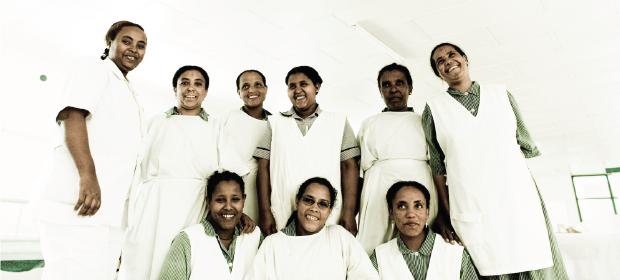Where We Work
See our interactive map


The Obama administration's Global Health Initiative (GHI) has taken the bold step of putting the principle of "women, girls, and gender equality" at the top of the list. Later this week, the GlobalHealth Council is hosting a discussion on the release of the GHI Supplementary Guidance Document on Women, Girls and Gender Equality. We hope that the GHI will take its focus on women and girls a step further in this guidance and provide the means to address gender inequality in the health workforce to improve the recruitment, productivity, and retention of female health workers.
Gender equality in human resources for health (HRH) means that women and men have an equal chance of choosing a health occupation, developing the requisite skills and knowledge, being fairly paid, enjoying equal treatment, and advancing in a career. When gender inequalities and discrimination operate in the workforce outside of the awareness of HRH leaders and managers, these inequalities may impede entry in health occupations or contribute to attrition, absences from work, lower productivity, poor health, and low morale of health workers. The result is a limited pool of formal and informal health workers to deal with today's health and development challenges, as described in IntraHealth's Gender Equality in HRH. A sound GHI health workforce strategy must address the critical issue of gender inequality, as noted in Saving Lives, Ensuring a Legacy. At present, though, key forms of gender discrimination and inequality are still out of the awareness of most human resource leaders and managers.
During a recent training in Uganda, I heard stories from human resources managers that bring home the problem of gender discrimination throughout the health worker employment cycle. The discrimination starts with recruitment, where jobs may not be advertised or may go to preferred nephews and not to qualified women, and where quid pro quo sexual harassment and bias operate in the actual recruitment discussions. The managers also pointed out that equal treatment at work is undermined when hidden fringe benefits—such as the use of a project car or opportunities to attend weekend or live-away training—are out of the reach of female workers whose family responsibilities preclude their travel.
Evidence of the barriers to women's entry to and retention in the health workforce has increased in the last ten years, in pre-service to service settings. There is also abundant evidence from other sectors in developing and developed nations about the ways direct and indirect discrimination impede equal opportunity and treatment for female workers, including pregnant, married, and unmarried workers with family responsibilities, as documented by the International Labor Organization in Maternity at Work: A Review of National Legislation, the European Union's Equal Opportunities Commission, and other reports.
To be responsive to women and girls in the health workforce, human resources leaders and managers must anticipate life-cycle needs and recognize that special actions are needed to ensure that marriage and motherhood do not constitute grounds to restrict female health workers' current and longer-term opportunities. These leaders and managers must become aware of the ways that gender stereotypes affect hiring, allocation of tasks, compensation, and promotion. And they must be sensitive to the workings of gender privilege in the conditions of work. Discrimination operates throughout a woman's life to restrict access to education and job markets. There are several broad HRH strategies which would improve the recruitment, productivity, or retention of female health workers.
Finally, recruiting for a robust health workforce requires long-term strategies to address the cultural and social disadvantages that girls face from their earliest years. This involves a commitment to girls' education and health, which are the foundations of women's workforce participation, economic productivity, and social autonomy. This would require working with communities to get and keep girls in school and end child marriages and child labor.
References
1. Standing H. 2000. Gender—a missing dimension in human resource policy and planning: special article. Human Resources for Health Development Journal 4(1).
2. Williams, J.C. and E.S. Westfall. 2006. Deconstructing the maternal wall: Strategies for vindicating the civil rights of "careers" in the workplace. Duke Journal of Gender Law and Policy 13: 31.
3. Williams J.C. and N. Segal. 2003. Beyond the maternal wall: relief for family caregivers who are discriminated against on the job. Harvard Women's Law Journal 26: 77-162.
4. Standing H. and E. Baume. 2001. Equity, equal opportunities, gender and organization. Performance Institute of Development Studies and World Health Organization.
Get the latest updates from the blog and eNews




